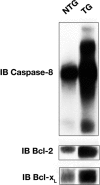Over-expression of a modified bifunctional apoptosis regulator protects against cardiac injury and doxorubicin-induced cardiotoxicity in transgenic mice
- PMID: 18805781
- PMCID: PMC2639090
- DOI: 10.1093/cvr/cvn257
Over-expression of a modified bifunctional apoptosis regulator protects against cardiac injury and doxorubicin-induced cardiotoxicity in transgenic mice
Abstract
Aims: Bifunctional apoptosis regulator (BAR) is an endoplasmic reticulum protein that interacts with both the extrinsic and intrinsic apoptosis pathways. We hypothesize that over-expression of BAR Delta RING prevents apoptosis and injury following ischaemia/reperfusion (I/R) and attenuates doxorubicin (DOX)-induced cardiotoxicity.
Methods and results: We generated a line of transgenic mice that carried a human BAR Delta RING transgene under the control of the mouse alpha-myosin heavy chain promoter. The RING domain, which binds ubiquitin conjugating enzymes, was deleted to prevent auto-ubiquitination of BAR and allow accumulation of the BAR protein, which binds apoptosis-regulating proteins. High levels of human BAR Delta RING transcripts and 42 KDa BAR Delta RING protein were expressed in the hearts of transgenic mice. When excised hearts were reperfused ex vivo for 45 min as Langendorff preparations after 45 min of global ischaemia, the functional recovery of the hearts, expressed as left ventricular developed pressure x heart rate, was 23 +/- 1.7% in the non-transgenic hearts compared with 51.5 +/- 4.3% in the transgenic hearts (P < 0.05). For in vivo studies, mice were subjected to 50 min of ligation of the left descending anterior coronary artery followed by 4 h of reperfusion. The infarct sizes following I/R injury, expressed as the percentage of the area at risk, were significantly smaller in the transgenic mice than in the non-transgenic mice (29 +/- 4 vs. 55 +/- 4%, P < 0.05). In hearts of mice subjected to cardiac I/R injury, BAR transgenic hearts had significantly fewer in situ oligo-ligation-positive cardiac cells (5.0 +/- 0.4 vs. 13.4 +/- 0.5%, P < 0.05). Over-expression of BAR Delta RING also significantly attenuated DOX-induced cardiac dysfunction and apoptosis.
Conclusion: Our results demonstrate that over-expression of BAR Delta RING renders the heart more resistant to I/R injury and DOX-induced cardiotoxicity, and this protection correlates with reduced cardiomyocyte apoptosis.
Figures






Comment in
-
Good news for mice with heart attacks: preventing acute myocardial injury by inhibiting apoptosis.Cardiovasc Res. 2009 Jan 1;81(1):1-2. doi: 10.1093/cvr/cvn300. Epub 2008 Nov 5. Cardiovasc Res. 2009. PMID: 18987050 No abstract available.
References
-
- Garg S, Narula J, Chandrashekhar Y. Apoptosis and heart failure: clinical relevance and therapeutic target. J Mol Cell Cardiol. 2005;38:73–79. - PubMed
-
- Van Empel VP, Bertrand AT, Hofstra L, Crijns HJ, Doevendans PA, DeWint LJ. Myocyte apoptosis in heart failure. Cardiovasc Res. 2005;67:21–29. - PubMed
-
- Zhu W, Zou Y, Aikawa R, Harada K, Kudoh S, Uozumi H, et al. MAPK superfamily plays an important role in daunomycin-induced apoptosis of cardiac myocytes. Circulation. 1999;100:2100–2107. - PubMed
-
- Kang YJ, Zhou Z-X, Wang G-W, Buridi A, Klein JB. Suppression by metallothionein of doxorubicin-induced cardiomyocyte apoptosis through inhibition of p38 mitogen-activated protein kinases. J Biol Chem. 2000;275:13690–13698. - PubMed
Publication types
MeSH terms
Substances
Grants and funding
LinkOut - more resources
Full Text Sources
Medical
Molecular Biology Databases

